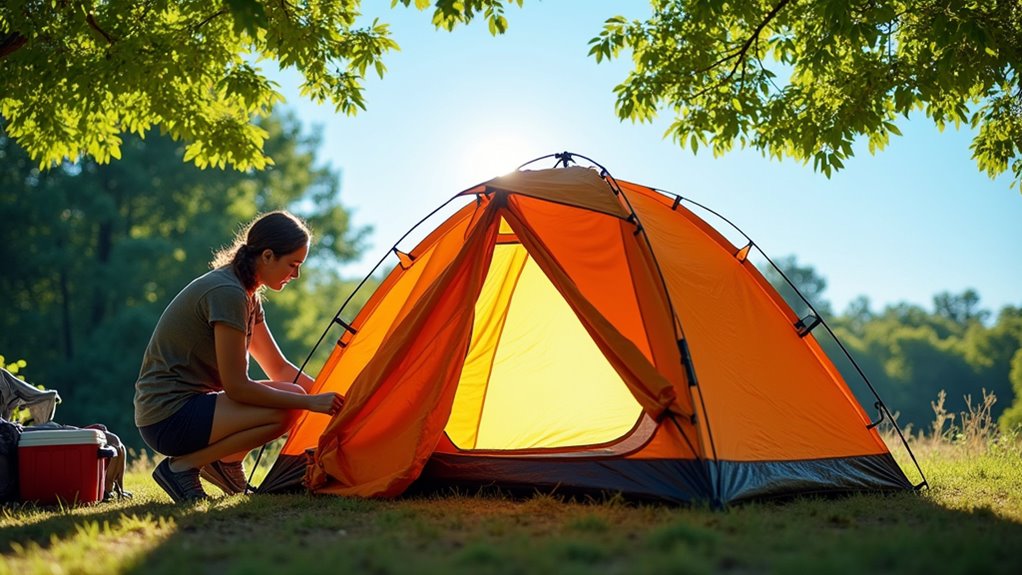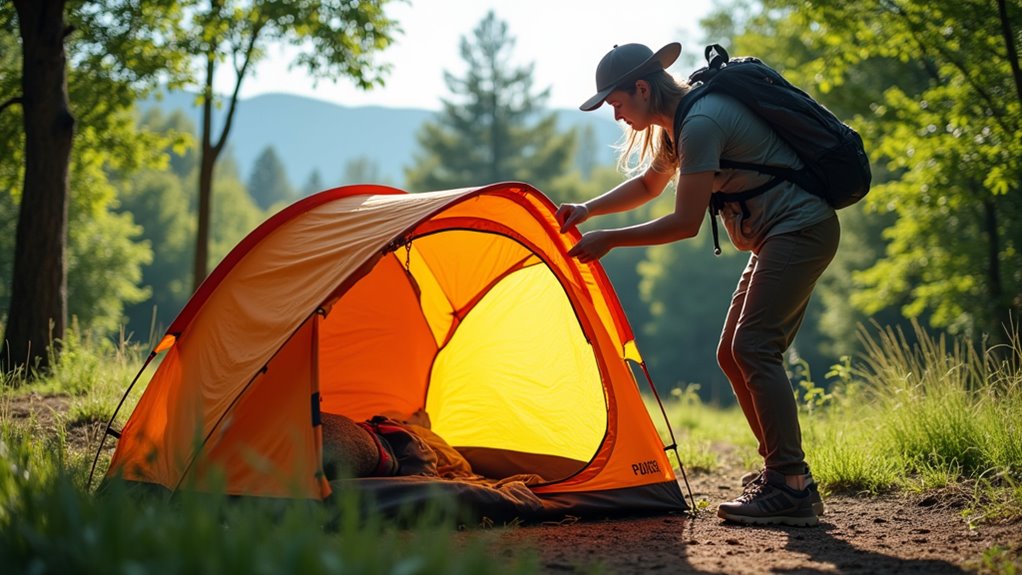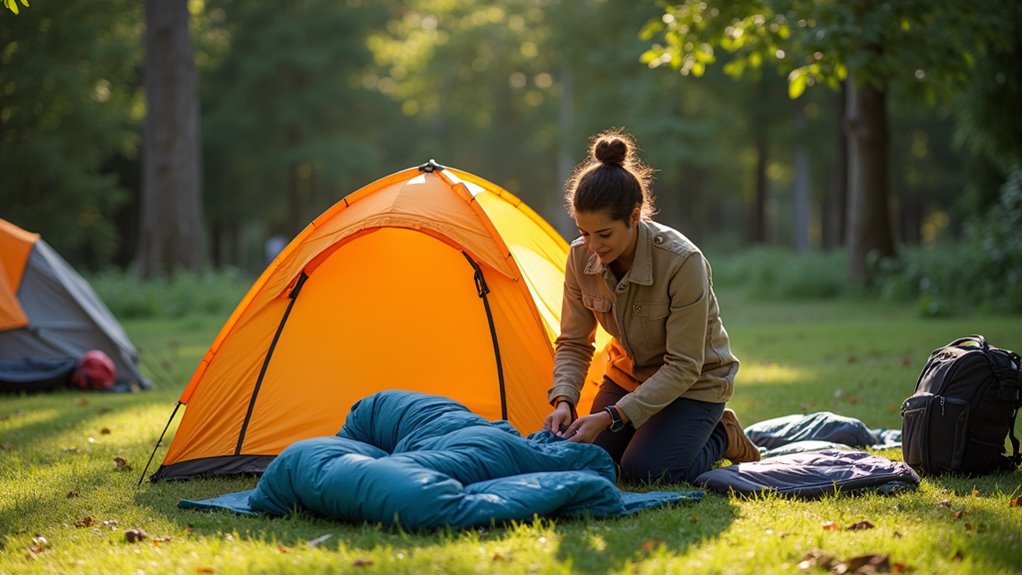How To Collapse A Pop Up Tent
This post contains affiliate links. As an Amazon Associate, we earn from qualifying purchases.
To collapse your pop-up tent, begin by cleaning it and making sure it is completely dry to prevent mold. Next, release the frame locks by gently pushing sliders or pulling pins, then fold the frame down evenly. Remove all accessories and keep the doors zipped to help maintain its shape. Finally, pack the tent into a breathable bag and store it in a dry, shaded area away from direct sunlight. Further explanation and tips on handling common issues are provided later in this article for those interested.
Essential Facts in 30 Seconds
- Clean and dry the tent fully before collapsing.
- Release frame locks evenly to maintain balance.
- Fold the frame carefully and unlock legs completely.
- Check fabric for damage and fold gently.
- Store tent in a cool, dry place with airflow.
Preparing to Collapse the Tent

Start by cleaning your pop-up tent well. Remove dirt and leaves by shaking it or brushing with a soft broom. Use mild soap and a soft brush for tough stains.
Make sure the tent is totally dry. Let it dry in the sun to stop mold and mildew. Open all doors and windows to let air flow inside. Check corners for water drops. Use towels to dry the tent if you can’t dry it outside.
Take out all stakes and ropes. Put small parts in a bag so you don’t lose them. Spread the tent flat on a clean, dry spot. Check for sharp things around the tent. Following these steps helps your tent last longer and keep it ready for next use, as a clean and dry tent is essential for longevity. Easy and safe!
Releasing the Tent Frame Locks
The tent frame locks hold the structure tight. Find these locks on the legs or corners.
Push sliders or pull pins gently to unlock. Release each corner evenly to keep balance. It is important to check for adjustments to ensure the tent remains stable during the collapsing process.
Check the frame moves easily before folding the tent. This method makes collapsing quick and safe. Additionally, visualizing the tent as a large, flat circle can help in managing the folding process effectively.
Unlocking Mechanism Overview
Releasing the tent frame locks helps you collapse your pop-up tent fast. Levers control these locks. Press or lift them to unlock the frame. Some levers have colors or textures for easy spotting. Understanding the collapsing process will ensure a smoother takedown.
Additionally, ensure the tent is clean and dry before attempting to fold it, as this will help prevent damage to the fabric and maintain its longevity.
Some tents use pins with springs. Pull or slide these pins against the spring to open. Sliding sleeves or twist-lock collars may need moving too. Each part helps the tent fold small. Knowing how they work before you start folding is essential.
Symmetrical Release Technique
Master the symmetrical release technique to collapse your pop-up tent safely. This method keeps tension balanced across the frame. It stops damage and makes folding easier.
Follow these clear steps:
- Grip opposite locks at the same time. Apply even pressure.
- Watch frame corners and sidebars to keep them aligned.
- Press release buttons or levers on matching spots. This frees tension evenly.
- Lower pressure slowly on locked joints. Guide the frame to fold along its hinges.
This technique protects your tent and speeds up packing. Additionally, ensure the tent is clean and dry before packing to prolong its lifespan. Properly collapsing the tent not only prevents wear but also enhances your overall camping experience. Try it to make tent collapse smooth and safe.
Ensuring Frame Freedom
Collapsing your pop-up tent goes smoothly by releasing the frame locks properly. Identify the lock type first: spring-loaded pins, sliding collars, or push/pull buttons.
Pull locking pins straight out to release the lock collar. Slide collars down to free the frame. Press buttons on pin assemblies to remove tension. As you release the locks, ensure the canopy fabric is not caught in the frame to prevent any potential damage.
Release locks one corner at a time with steady force to avoid jamming. Clean locks regularly and apply dry lubricant lightly to keep them working well. Following these steps prevents damage and makes folding your tent easy and fast. Additionally, ensure the tent is properly aligned during the collapsing process to facilitate a smooth fold.
Folding the Tent Frame
Prepare your pop-up tent frame for folding to save time and avoid damage. Start by removing all accessories, such as the canopy fabric and stakes. This prevents tears and keeps parts safe.
Close mesh doors and windows. This keeps the fabric tight and stable. Lay the tent flat on a clean surface. Avoid bending or straining the frame. Unlock any locks on the legs. Then, shorten the legs to their smallest length.
Push the top panel toward the center. Fold the front frame down carefully, leaving small gaps. This helps reduce tension on the frame.
Press the frame sides inward evenly. Watch out for pinch points to protect your fingers. Handle the frame gently and use the right angles. This keeps the frame strong and ready for storage. Remember to secure the folded tent with straps to prevent it from springing back open.
Follow these steps for a smooth, safe folding process.
Safety and Efficiency Tips

Collapse your pop-up tent with a friend. Two people work faster and safer.
Hold the fabric gently. Avoid tears or snags. Torn fabric weakens the tent.
Practice folding your tent often. This builds speed and confidence. Quick folding saves time at campsites. It also keeps your tent in good shape.
Simple steps make tent care easy. Try it today and see the difference.
Partner Assistance Benefits
Managing a pop-up tent with a partner boosts safety and speed. Teams of two cut injury risks by half.
One person holds the frame steady. The other folds sections smoothly. This teamwork speeds packing by up to 30%.
Partners spot dangers faster and fix problems right away. Clear talk keeps the process quick and safe.
Simple teamwork makes a big difference.
Careful Fabric Handling
Careful fabric handling helps your pop-up tent last longer.
Check the fabric for dirt or wet spots first. Dirt and moisture can weaken it. Use a soft cloth or a cleaner made for canopies to clean the fabric.
Fold the tent gently to avoid stress on fold points. Stress can cause tears. Always fold along the natural seams. Support the fabric evenly and avoid pinching.
Lay it on a smooth surface to stop snags. Rough handling can wear off protective coatings. Treat your tent with care. This keeps the fabric strong and your tent useful for many years.
Practice for Efficiency
Practice makes collapsing your pop-up tent faster and easier. Good habits save time and keep your tent safe.
Follow these four steps for better results:
- Check inside the tent for all items before folding it.
- Loosen guy lines and anchors carefully to avoid sudden snaps.
- Have one person hold each leg. Lower the tent evenly to stop damage.
- Slowly unlock the frame parts while folding. Lock them again when done.
Packing and Storing the Collapsed Tent

Packing and storing your collapsed pop-up tent correctly keeps it strong and ready.
Clean the fabric well to remove dirt and wet spots. Wet fabric causes mildew and bad smells. Let the tent dry fully before packing.
Check the fabric for holes or tears. Fix small tears to make the tent last longer.
Fold the tent gently, so the fabric and frame don’t get damaged. Use the original bag if it fits. If not, choose a bigger bag that lets air flow.
Store the tent in a cool, dry place. Avoid direct sunlight and damp areas. These can ruin the fabric and frame.
Use shelves or hooks to keep the tent and poles neat and separate. Check the tent now and then for wetness or damage.
Taking care of your tent like this means it lasts many camping trips.
Common Difficulties and Solutions
Setting up or folding your pop-up tent can bring some common problems. Knowing these helps keep the tent steady and strong against wind.
- Wind Problems: Strong wind can blow the tent down. Use stakes or heavy weights to hold it tight.
- Frame Trouble: Frames can bend or break. Frames made of aluminum or steel last longer.
- Water Collecting: Water can stay on the tent roof if it doesn’t fit well. Tighten the roof or use fabric that blocks water.
- Spring Pins Stuck: Pins in the frame can get stuck. Use a tool to line them up carefully. Press gently to fold the tent right.
Fixing these issues makes folding your tent easier and safer. It saves time and stops stress.
Frequently Asked Questions
Can I Collapse the Tent Alone, or Do I Need Help?
Collapsing a tent alone is possible with practice. Learn how the tent folds and snaps into place. Take your time to avoid breaking poles or tearing fabric. Use simple steps: loosen stakes, fold the rainfly, collapse poles carefully. Practice at home before camping. This skill saves time and effort when camping solo. Stay safe and handle parts gently. Soon, folding the tent will feel easy and quick.
How Long Does It Typically Take to Collapse a Pop up Tent?
Collapsing a pop-up tent usually takes only a few minutes. Using the right folding steps helps a lot. Practice makes the process faster and easier. Keep your tent clean and dry to avoid problems. Soon, folding your tent will feel quick and natural.
What if the Tent Fabric Gets Damaged During Folding?
Tent fabric can tear during folding. Stay calm. Check the damage closely. Use tent repair tape to fix small tears quickly. Avoid pulling or stretching the fabric too hard. Clean the fabric gently after each use. Regular care helps stop tears from growing. Good maintenance can make your tent last many years. Small fixes now save big problems later. Keep your tent strong and ready for your next trip.
Are There Specific Tools Needed for Collapsing the Tent?
Collapsing a tent does not require special tools. Folding the tent carefully helps avoid damage. Keeping the tent frame steady makes folding easier. Wearing gloves can protect your hands from rough edges. A good folding method saves time and keeps the tent neat. Simple care keeps your tent ready for the next trip.
Can I Store the Tent Outside in a Shed?
Storing your tent in a shed can work well. Check the shed for damp spots and bugs. Moisture causes mold and damage fast. Keep the tent dry and clean before storing it. Use a breathable bag, not plastic, to avoid trapping moisture. Organize the shed to keep pests away. This care helps your tent last many seasons.
Conclusion
Collapsing a pop-up tent can feel tricky at first. Nearly 70% of campers find it hard to pack up tents sometimes. Start by unlocking the frame carefully. Then, fold the frame along the creases. Keep the fabric neat and smooth as you fold. Pack the tent into its bag without rushing. Store it in a dry place to avoid damage. Taking good care helps your tent last longer. Practice a few times, and you will get faster. This skill makes camping easier and more fun.
